With my recent enfatuation for botany (plants) and mycology (fungi), I have been expanding my roots a bit, and really 'soaking it all in'. (No pun intended.)
With a bit of research I have properly identified (and edited in my last post) the following plants:
1 - Squawroot, or American Cancer Root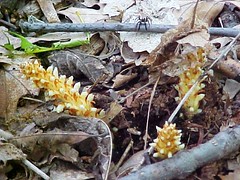
In the northeastern United States, where oak trees run rampid, you will sometimes find Squawroot, at the tree base. This little bugger has baffled me for months, since I had first seen it last year. Nobody seemed to know what it was called, so I set out to do my research with success!
The Squawroot is a member of the broomrape family, and has no chlorophyll(the green stuff) that most plants use to survive. Therefore, it is parasitic, soaking life from those that DO produce chlorophyll, and in the case of Sqawroot, that specific plant is the OAK tree. (I knew the little bastards were parasitic, they grow in clusters around oaks all the time around here.)
Unlike many parasite plants, the Squawroot doesn't cause death in the host. In short, the tree will remain healthy and strong despite it's existance along the root systems. The lack of chlorophyll means it doesn't need sunlight to grow, allowing it to grow in complete darkness.
That aside, Squawroot was used by Indians here in the Northeastern US for medicinal purposes. We know today that the plant can be used to treat hemorrhages of the bowel, uterus, and help treat headaches. It is also an important dietary suppliment of Black Bears in spring and early summer.
2- Daisy Fleabane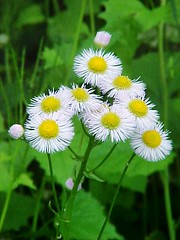
I knew it was a daisy of sorts, but when I took this picture yesterday, it remained nameless until I discovered the true name: Daisy Fleabane. The specific Daisy Fleabane that I photographed, is the "Lavender" variety.
The head of a daisy fleabane is around a half-inch, and has up to four times as pany "petals" as the ever-popular "ox-eye daisy". These flowers first appear in late spring, and got the name "Fleabane" because it was once believed the repelled fleas! Early settlers hung these flowers in their cabins to drive out fleas, which continued for quite some time! Today, scientists see no valid proof that this plant has any insect repelling ability. In fact, the Daisy Fleabane attracts more of a variety of insects than most flowers! Bees, beatles, flies, butterflies, and even plant eating insects thrive around Daisy Fleabane. This feature also makes them a popular hunting spot for the Crab Spider, who eats the insects visiting the flower head.
So, at the end of the day the Daisy Fleabane is a bountiful insect station full of insects, and on occassion, crab spiders who adopt the flower as their own, hiding underneath the rim of the flower.
Take a closer look next time.
3 - Wild Dog Rose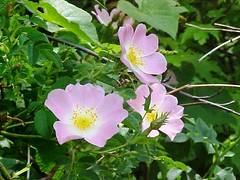
Who doesn't love roses?
Well, the flower above is the wild dog rose that really started it all! I noticed this particular shrub growing about 20 yards away from my grandparents compost pile, right inside the edge of the woods, looking out onto the field.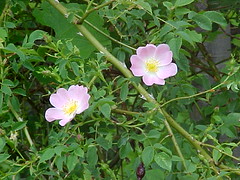
The pink hue is beautiful, and what I like most about this species of rose is that it's not overly flamboyant with dozens of petals and neon colors. It's beauty is a bit more quiet, subtle, and wild than that of the rose we've mutated today.
4 - Clematis
Not wild, but ever beautiful...I opted to take some snapshots of my grandma's white and neighbors purple vine-like flowers. Though an ornamental flower, I thought this discovery was worth a mention, and a few pictures.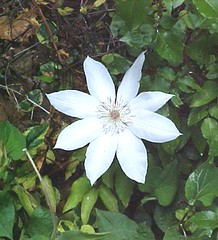
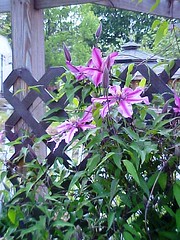
5 - Buttercup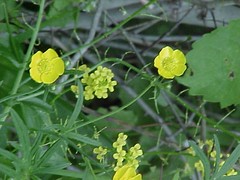
I called it buttercup already, but I wasn't totally sure until yesterday that it was actually the true name. There are different varieties (like over 120) so I haven't found what kind of SPECIFIC species this is.
Moreover, I'm still wondering what the smaller yellow flower is. Is it also a type of buttercup?
Ah, the wonders of nature.
Wednesday, May 31, 2006
Root Expansion
Posted by
Michael
at
1:55 PM
![]()
Subscribe to:
Comment Feed (RSS)




|